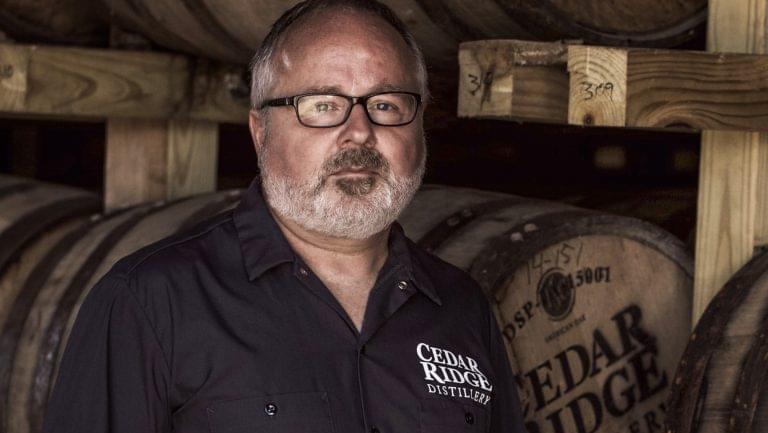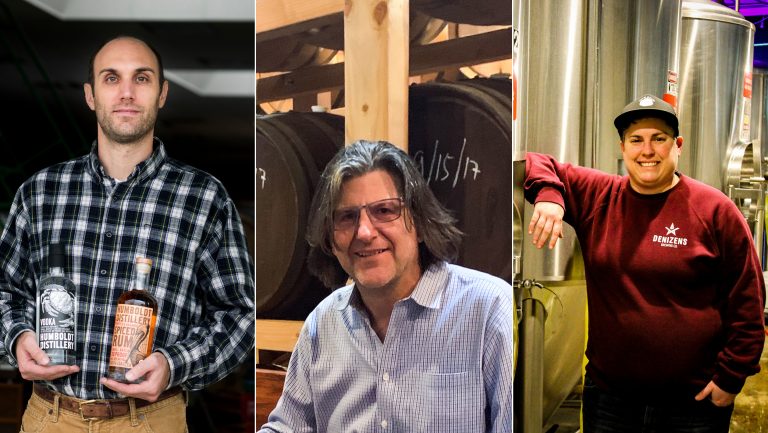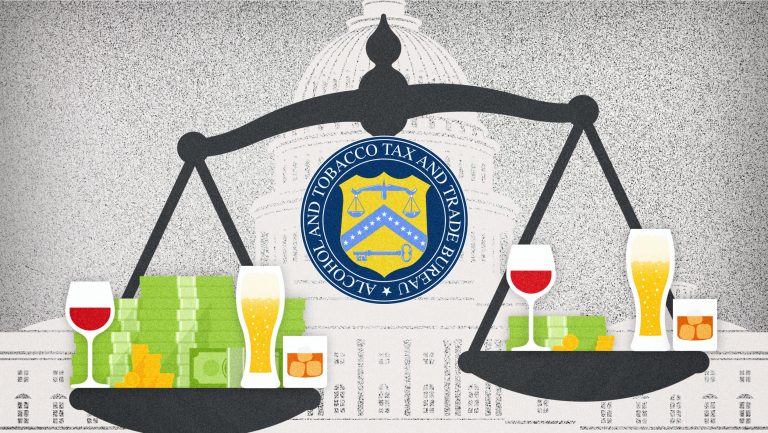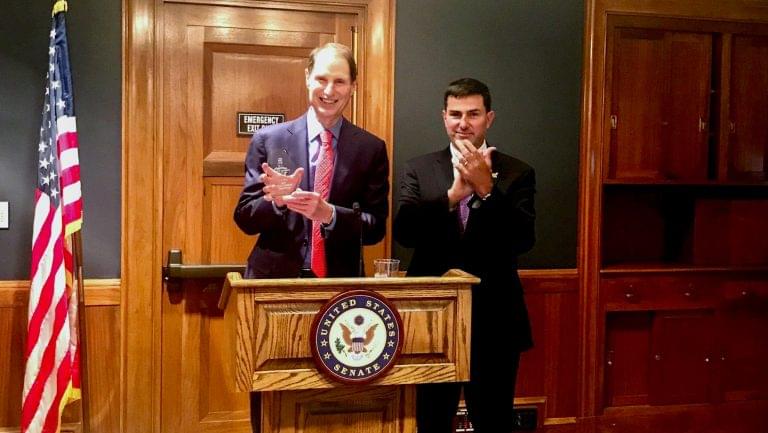If the tax breaks that the U.S. alcohol industry has gotten used to over the past year expire at the end of 2019, as scheduled, the cost to individual producers could be millions of dollars. But if the Craft Beverage Modernization and Tax Reform Act (CBMA), which was passed by Congress in late 2017, is made permanent—as many legislators and members of the industry are hoping it will be—the federal excise tax (FET) for producers of wine, beer, and spirits would be permanently lowered. This would not only translate into millions of dollars’ worth of savings in the coming years for individual producers, but could also lead to new jobs, new equipment, bigger salaries, and even health benefits for tens of thousands of workers.
Jeff Quint, the founder of Cedar Ridge Winery & Distillery in Swisher, Iowa, believes that making the CBMA permanent is essential to the future of the beverage industry. He has been actively lobbying legislators and most recently met with Senator Joni Ernst (R-IA), on April 24. “It’s on us to push this,” Quint says, adding that he and several of his industry cohorts are working to exert their influence.
For a follow-up to our earlier story outlining the CBMA’s key provisions, SevenFifty Daily spoke with beverage industry experts about what a return to the former FET rates could mean for wineries, breweries, and distilleries. One concern is that if the CBMA doesn’t pass, producers may be faced with the difficult choice of whether to scale back on planned investments or pass the costs on to consumers.

Don’t miss the latest drinks industry news and insights. Sign up for our award-winning newsletters and get insider intel, resources, and trends delivered to your inbox every week.
Another is that without the lowered FET, some producers believe their businesses will struggle to stay afloat. This is of particular concern in a market in which sales of beer, wine, and spirits seem to be slowing, as suggested by Nielsen, which reported that during the 52-week period that ended on March 23, 2019, beer sales saw a decline of 0.1 percent, wine sales grew 2.2 percent, and spirits sales grew 3.9 percent, as compared with Nielsen research figures from the 52-week period that ended on March 26, 2016, when beer sales increased 3.5 percent, wine sales expanded 5 percent, and spirit sales grew 6.5 percent.
The Genesis
In February of this year, Senate Finance Committee ranking member Ron Wyden (D-OR) and Senator Roy Blunt (R-MO) introduced the Craft Beverage Modernization and Tax Reform Act of 2019. This bill aims to make permanent the reduced taxes and revamped regulations that winemakers, brewers, distillers, and others have been benefiting from since 2017. Similar legislation was introduced in the House by Representative Mike Kelly (R-PA) and Representative Ron Kind (D-WI). The 2017 bill received widespread bipartisan support and was greeted with enthusiasm by members of the drinks industry.
When introducing the 2019 legislation in February, Blunt pointed out that the wine industry supports 30,000 jobs in Missouri and contributes an estimated $3.2 billion each year to the state’s economy. The beer industry has created 57,000 direct and indirect jobs in the state and generates $3 billion in wages and benefits, and the spirits sector has created 26,000 jobs in Missouri, pumping $1.9 billion into the economy.
“The craft beverage industry is driven by small businesses that support thousands of jobs and contribute billions in economic output,” Blunt said. “This bill will remove tax and regulatory barriers that are making it harder for Missouri’s brewers, distillers, and winemakers to grow and compete.”
The legislators spearheading the new act aren’t just looking out for the welfare of the vintners, brewers, and distillers in their own states—the act, they say, has the potential to benefit the U.S. economy as a whole.
The CBMA of 2017 is set to expire on December 31, 2019. If the new act doesn’t get pushed through, producers say they stand to lose millions, and the growth enjoyed by some of them as a result of the tax breaks will likely grind to a halt. But what kind of impact have the new FET rates had on the ground? Here, we take a look at how the CBMA has changed the bottom line for winemakers, brewers, and distillers.
The Impact on Wineries
Wine is subject to an excise tax of between $1.07 and $3.40 per gallon, based on alcohol content and carbonation level. Before the CBMA of 2017, small domestic wineries (producing 250,000 gallons or less) were eligible for a tax break. The CBMA extended that benefit to medium and large producers, providing a tax credit to all wineries, regardless of production size, equal to $1 for the first 30,000 gallons produced, 90 cents for the next 100,000, and 53.5 cents for the following 620,000 gallons. It also, and for the first time, made producers of sparkling wine eligible for the same credit as producers of still wine. Additionally, wines up to 16% ABV are taxed at $1.07 a gallon. Previously, producers with wine above 14% were taxed at $1.57 a gallon.
“My winery produces 500,000 gallons a year, and the provisions have made an enormous impact on our bottom line,” says Hank Wetzel, the cofounder with his wife, Linda, of Alexander Valley Vineyards in Healdsburg, California. “The first year [2018],” he says, “we were able to save $300,000 in excise taxes and increase our profits by 40 percent.”
The savings, Wetzel says, are going directly back into the business, in the form of employee bonuses and improvements to the winery. “This savings will allow us to double our barrel capacity,” he says, “and if the break is made permanent, which I hope it will be, we will be able to grow our sales by 10 percent each year. All of the savings go right back into the local economy, primarily in the form of additional work and revenue for people in our region.”
How the CBMA Affects Distilleries
The CBMA reduces taxes on distilled spirits from $13.50 to $2.70 per gallon for the first 100,000 proof gallons produced or imported per year; it also reduces the rate of taxation to $13.34 per gallon for the next 22,130,000 gallons.

“The FET reduction has helped us more than any single thing I can think of,” says Cedar Ridge’s Quint. “The full tax of $13.50 sucked a tremendous amount of cash out of our account every two weeks; [now] we take the savings and reinvest it.” The tax break must be extended, he says. “It’s by far the most important thing we need to accomplish this [legislative] session to keep our developing industry in high growth mode. ”
Mark Shilling, the former president of the American Craft Spirits Association and the founder and managing principal of Shilling/Crafted, a distillery project management company in Austin, Texas, says the tax break, which amounts to an 80 percent reduction for the first 100,000 proof gallons, is significant for distillers. Before the act’s passage, he explains, craft spirits producers were paying about 5.4 times more in FET than craft brewers, and 16.4 times more than small wineries. “For the first time,” says Shilling, “this means parity on taxes for producers in our [sector of the] industry. There are currently around 1,800 craft distillers in the U.S., about 90 percent of which qualify as small—producing less than 10,000 proof gallons a year. That [results in] up to $108,000 in savings [annually], which is nothing for a huge producer but is enormous for a small one.”
Shilling says these producers are using the savings to invest in new employees, to buy equipment to increase production, and to buy grains and other products from local farms. Without the savings the CBMA has provided—and will continue to provide if the 2019 legislation is passed—he says they would have to reconsider all of these investments.
The Effect on Brewers
One of the ways the CBMA has benefited craft brewers is by cutting the FET on beer in half for domestic brewers who produce fewer than 2 million barrels of beer per year—they’re allowed to pay $3.50 per barrel on the first 60,000 barrels produced. All other brewers and beer importers have seen their tax per barrel reduced from $18 to $16 for the first 6 million barrels (higher levels of production remain at $18 a barrel).
“The FET put in place in 2018 saves small brewers $80 million annually,” says Bob Pease, the president and CEO of the Brewers Association in Boulder, Colorado. “The FET is an extra tax on top of [federal, state, and local taxes]. Brewing is a capital-intensive endeavor, and the recent tariffs on aluminum and steel put in place by the [federal government] have put additional stress on brewery owners.” Extending the FET reductions, he says, would stabilize and help to balance out the impact.
If the CBMA doesn’t move forward, some craft brewers say that their expansion plans will need to be reconsidered. “The CBMA needs to be made permanent if small-scale brewers are going to compete,” says Julie Verratti, the cofounder with Emily Bruno and Jeff Ramirez of Denizens Brewing Co., based in Silver Spring, Maryland. “We’re in the process of expanding the 1,500 barrel capacity of our brewery. Without the tax break, we’ll be forced to reconsider our expansion, and we’ll also be less likely to purchase expensive small-batch grains from farmers in our region, because we’ll no longer be able to afford it.”

Next Steps for the Legislation
The CBMA will be considered by the Senate Finance and the Ways and Means committees, respectively, before being sent on to the Senate and House for a vote, and both the Senate and the House must pass it for the legislation to become permanent. The Senate version of the bill has 16 cosponsors, evenly split between Democrats and Republicans. The House version has 14 cosponsors, also evenly split between parties. Rep. Kelly’s office says that the congressman “is working hard to make clear how important this bill is to his colleagues on both sides of the aisle,” adding that there are currently 43 Republicans and 39 Democrats in favor of the bill. To pass a bill by simple majority in the House, 218 votes in total are needed. Producers remain optimistic about the bill passing, but they’re still anxious to lock in votes.
Quint cautions that there will be serious repercussions for the industry—and the consumer—if “a great number of these exciting young craft distilleries fall off the map if the FET quintuples at the end of the year.”
Abe Stevens, the founder of Humboldt Distillery in Fortuna, California, echoes Quint’s concerns, and adds another warning. “Thanks to the CBMA, we were able to hire two new employees,” he says. “But if it’s not renewed, it will reduce our ability to bring new jobs to our rural community.”
The CBMA has helped lift up small-scale farmers in rural communities as well, producers note. Adam Spiegel, the CEO and distiller of Sonoma Distilling Company in Rohnert Park, California, says that if the tax breaks are not extended, it will affect “all of the farmers and suppliers we work with,” adding that 70 to 80 percent of Sonoma Distilling’s mash bill is made from local, non-GMO grains. Without the break, he says, the company may need to reevaluate the quantity of high-quality locally-grown grains they purchase.
Without the CBMA—and especially given the slowed sales growth of the past year—members of the industry can be expected to pull back on plans for expansion, and doing so would not only affect their businesses’ bottom lines, but could create a domino effect of lost revenue in the agricultural communities in which they live and work, as well as for any adjacent companies they do business with, from coopers and equipment manufacturers to packaging suppliers.

Dispatch
Sign up for our award-winning newsletter
Don’t miss the latest drinks industry news and insights—delivered to your inbox every week.
Kathleen Willcox is a journalist who writes about food, wine, beer, and popular culture; her work has appeared in VinePair, Edible Capital District, Bust magazine, and Gastronomica, and on United Stations Radio Networks, among other venues. She recently coauthored, with Tessa Edick, “Hudson Valley Wine: A History of Taste & Terroir.” She lives in Saratoga Springs, New York.






